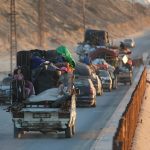In the midst of the ongoing Gaza conflict, one of the most shocking incidents has once again placed Israel’s military strategy under global scrutiny. A hospital strike that killed journalists covering the war has sparked outrage across the world, raising serious questions about press freedom, civilian safety, and the ethics of warfare.
- Background of the Gaza Conflict
- The Hospital Strike Incident
- Israel’s Defense of the Strike
- Reactions from Journalistic and Human Rights Organizations
- Impact on Global Journalism
- International Humanitarian Law and Journalists’ Rights
- Humanitarian Concerns Around Hospital Strikes
- The Narrative Battle: Israel vs. Hamas
- Voices from the Ground
- Global Diplomatic Fallout
- Future of Journalism in Conflict Zones
- FAQs
- Conclusion
Israel defended the attack by claiming that Hamas was using a camera crew near the hospital as “cover” for its operations. This justification, however, has been widely criticized by human rights organizations, media watchdogs, and international observers. For many, the strike is not only a military controversy but also a test of accountability in modern warfare, where the line between legitimate military targets and civilian life continues to blur.
Background of the Gaza Conflict
The Gaza conflict is one of the most protracted and devastating crises in the Middle East. Since Hamas took control of Gaza in 2007, the strip has witnessed repeated wars and flare-ups between Israel and Hamas.
A Cycle of Violence
- Israel argues its strikes are acts of self-defense against Hamas rocket attacks.
- Hamas claims it is resisting occupation and defending Palestinian sovereignty.
- Civilians, however, remain the primary victims, caught between airstrikes, blockades, and humanitarian collapse.
Hospitals, schools, and press offices have repeatedly been hit in these clashes, fueling international criticism of both Israel and Hamas for alleged violations of international humanitarian law.
The Hospital Strike Incident
The recent strike occurred near a medical facility in Gaza, where journalists had gathered to report on the humanitarian crisis.
What Happened?
- A missile struck an area adjacent to the hospital.
- At least several journalists were killed instantly, while others were seriously injured.
- Patients and medical staff inside the hospital were also forced into panic as debris shook the building.
Witnesses reported that the journalists had clearly identified themselves with press vests and cameras. The hospital strike thus immediately raised suspicions of a violation of the Geneva Conventions, which provide protections for both medical facilities and journalists in war zones.
Israel’s Defense of the Strike
The Israeli Defense Forces (IDF) defended the attack by claiming that Hamas had been using journalists’ cameras and media crews as a form of cover.
The IDF’s Justification
- Israel claimed Hamas fighters were positioned close to the hospital.
- It alleged that Hamas militants were exploiting the presence of the press to shield their activities.
- Military spokespersons insisted the strike targeted “legitimate threats” and not journalists themselves.
An IDF statement read: “We regret any harm to non-combatants, but Hamas has repeatedly endangered civilians and media personnel by embedding its operations within civilian infrastructure.”
Reactions from Journalistic and Human Rights Organizations
The defense did little to calm the storm. Organizations around the world condemned the incident as an attack on press freedom and human dignity.
Condemnations
- Reporters Without Borders (RSF): Called the strike “an unacceptable violation of international law.”
- Committee to Protect Journalists (CPJ): Demanded an independent investigation, stating, “Journalists are not collateral damage. They are observers who must be protected.”
- Human Rights Watch: Warned that such justifications could normalize the targeting of the press.
The outrage was not limited to advocacy groups. Several governments demanded accountability and transparency in Israel’s investigation of the incident.
Impact on Global Journalism
This attack is part of a disturbing trend where journalists in war zones are increasingly finding themselves in the crosshairs.
Statistics on Journalist Casualties in Gaza
- Since the start of the conflict, dozens of journalists have been killed in Gaza.
- Many were working for local outlets with limited safety resources.
- Others were freelancers, risking their lives to bring global audiences unfiltered information.
The strike further raises the fear that journalism itself is being criminalized in conflict zones. The chilling effect is already evident, as some media organizations are reconsidering sending reporters into Gaza, depriving the world of firsthand coverage of a humanitarian catastrophe.
International Humanitarian Law and Journalists’ Rights
Under Article 79 of Additional Protocol I to the Geneva Conventions, journalists in war zones are considered civilians and must be protected unless they take direct part in hostilities.
Key Legal Principles
- Distinction: Warring parties must distinguish between combatants and civilians.
- Proportionality: Attacks should not cause excessive civilian harm compared to military advantage.
- Press Protection: Journalists carrying cameras or wearing “PRESS” identification are entitled to civilian protections.
Critics argue that Israel’s justification risks undermining these principles by blurring the distinction between legitimate targets and journalists.
Humanitarian Concerns Around Hospital Strikes
Hospitals are afforded special protections under international law. Any strike near or within medical facilities is almost always condemned unless there is irrefutable evidence of them being used for military purposes.
Consequences of Targeting Medical Sites
- Disruption of essential care for civilians.
- Long-term fear among medical staff and patients.
- Deterioration of trust in conflict parties respecting humanitarian norms.
In Gaza, where the health system is already on the verge of collapse due to shortages of medicines, staff, and equipment, such attacks compound an already dire situation.
The Narrative Battle: Israel vs. Hamas
In modern conflicts, warfare is not just about weapons but also about narratives.
Israel’s Narrative
- Positions itself as defending against terrorism.
- Claims Hamas embeds fighters in civilian zones, including hospitals and schools.
Hamas’s Narrative
- Frames Israeli strikes as evidence of systematic targeting of civilians.
- Uses such incidents to rally international sympathy and support.
The hospital strike thus becomes more than a battlefield incident—it turns into a global information war.
Voices from the Ground
The human cost of the strike cannot be understood without listening to those directly affected.
- A survivor journalist recounted: “We were filming near the hospital. The next moment, everything was fire and smoke. My colleagues fell next to me. They had only cameras, not weapons.”
- A doctor at the hospital said: “We had to evacuate patients in the middle of the night. We feared another strike would hit.”
- A family member of a killed reporter shared: “He wanted the world to see our suffering. Instead, he became another victim of it.”
These testimonies underline the devastating consequences of the strike, beyond political and military rhetoric.
Global Diplomatic Fallout
The incident has triggered intense diplomatic discussions.
- United Nations: The UN Secretary-General expressed “profound concern” and called for strict adherence to international law.
- European Union: Condemned the strike and urged for independent monitoring of Israel’s military actions.
- United States: While reaffirming Israel’s right to self-defense, Washington emphasized the need to protect journalists and civilians.
The diplomatic fallout highlights how such incidents risk isolating Israel on the global stage, particularly in Europe and the Global South.
Future of Journalism in Conflict Zones
The hospital strike raises pressing questions about the safety of journalists worldwide.
Possible Outcomes
- Greater pressure on governments to implement safety guarantees for reporters.
- Increased reliance on remote or citizen journalism, though less reliable.
- Calls for stronger international mechanisms to hold violators accountable.
The question remains: if journalists are no longer safe even with “PRESS” markings, who will tell the stories of wars?
FAQs
What happened in the hospital strike in Gaza?
A missile struck near a hospital, killing several journalists and injuring others. Israel claimed Hamas was using the journalists’ presence as cover.
Why is Israel defending the strike?
The IDF argued that Hamas was embedding operations near the hospital and exploiting press crews to shield its fighters.
Are journalists protected under international law?
Yes. Journalists are considered civilians under the Geneva Conventions and must not be targeted unless they directly participate in hostilities.
How many journalists have been killed in Gaza?
Dozens of journalists have been killed since the escalation of the conflict, making it one of the deadliest wars for the press in recent history.
What has been the global reaction?
Human rights groups, governments, and media organizations have condemned the strike, demanding accountability and investigations.
Conclusion
The hospital strike that killed journalists in Gaza is more than just a military incident—it is a profound moral and legal crisis. Israel’s defense that Hamas used journalists as cover underscores the complexities of modern warfare, where propaganda, narrative, and military action often intertwine.
Yet, at its core, the tragedy highlights the immense vulnerability of civilians and journalists in war zones. Those who risk their lives to document truth and give a voice to the voiceless deserve protection, not death.
As the world debates the legality and legitimacy of Israel’s actions, one fact remains clear: without journalists, the realities of war would remain hidden, and accountability would vanish into silence. Protecting the press is not optional—it is essential to safeguarding truth, justice, and humanity.








